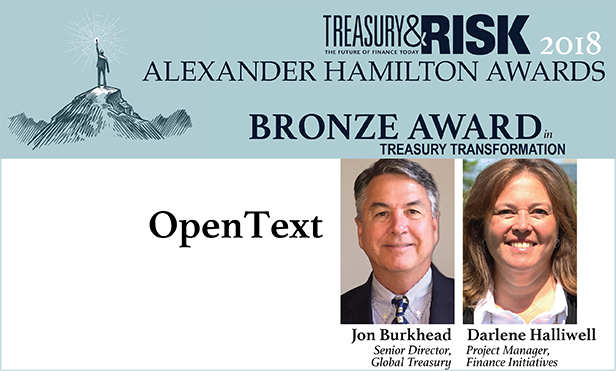
OpenText was founded in 1991 by academics looking to create a searchable online dictionary. Given this original raison d'etre, the organization's growth in the years since has been remarkable. “We've made 61 acquisitions, deploying a total of more than $6 billion of capital,” explains Jon Burkhead, senior director of global treasury for OpenText. “We average two to three acquisitions per year.”
In its two and a half decades of existence, OpenText has evolved into a diversified software and services company with offerings ranging from document imaging and information management systems to a SWIFT service bureau. It has also expanded geographically: Based in Waterloo, Ontario, OpenText operates globally, with 41 percent of sales coming from outside the Americas. Thanks to its ongoing, multifaceted growth, OpenText is a force to be reckoned with in the enterprise software market. At the same time, the acquisitions have complicated life for back-office functions such as treasury.
“A few years ago, we were managing all our treasury activities on a spreadsheet,” Burkhead says. “It worked when OpenText was smaller, but the more acquisitions we completed, the more banks and accounts we had to deal with. By the end of 2014, three people were spending a lot of time logging into different bank portals and manually downloading the statements and transactions. Since we operate two shared service centers, we support nearly 100 other users who were going into the bank portals to initiate payments, retrieve statements, and inquire on banking transactions. We had 420 accounts at 120 different banks, and we literally had people walking around with bags of tokens for accessing portals. We couldn't continue doing things that way.”
OpenText undertook an initiative to rationalize its global bank account structure and to automate as many treasury activities as possible. Burkhead enlisted the help of OpenText's project manager for finance initiatives, Darlene Halliwell. Together, they established a target of consolidating most of the company's business with five global banks. “We still needed regional banks in some places, either due to local laws or business considerations,” Halliwell says. “But we set a goal of reducing the total number of banks we worked with from 120 to less than 20.”
Halliwell headed up a project team that consisted of subject matter experts from the company's accounts receivable (A/R), accounts payable (A/P), payroll, tax, controllership, and legal functions. “Before we launched this project, treasury did a cost-benefit analysis that secured senior management's buy-in to our objectives,” Burkhead says. “The support of senior management helped us convince groups throughout the company to dedicate resources to our initiative.”
The project team's first step was to select five banks as global partners based on their footprint, capabilities, cost, and commercial relationship with OpenText. After making those decisions, OpenText invited the partner banks to join weekly project-update meetings. “We tapped into the banks' knowledge about best practices and local banking practices,” Burkhead says. “For example, Citibank was one of our strategic banks, and they played a key role in helping us design the EMEA [Europe, Middle East, and Africa] banking network and pooling structure which had more complexity.”
The next step was to evaluate the rationale behind each bank account the company maintained. “We went region by region, account by account, and bank by bank, and we questioned what we were doing and why we were doing it,” Burkhead says. “In the past, we had instances where we would open a new account just because a single customer wanted to pay in a different currency than our functional currency in that country. In this project, we performed a cost-benefit analysis on every account. We wanted to get down to one or two operating accounts per entity per country, and to close any account that didn't have a convincing business justification.”
Another key component of the project was the deployment of a corporate treasury management system. OpenText rolled out a Kyriba solution and built a payment hub within the OpenText corporate Managed Services group. Rather than logging into a different portal for every bank, treasury and A/P staff now initiate and approve payments through the treasury management system, which then pushes the payment to OpenText Managed Services for payment directly through to the banks. For banks that have lower volumes of OpenText transactions, payments flow through SWIFT. Bank statements automatically flow in the opposite direction.
“The OpenText Managed Services group has become our aggregator for statements and payments,” Burkhead says. “Their direct connectivity to the banks has been integral to the company's ability to streamline our payment and bank account management processes.”
 Liquidity management was one more area of focus for the initiative. The project team divided OpenText's business into regions—North America, EMEA, APAC (Asia-Pacific), and LATAM (Latin America). Cash pools were subsequently set up in North America, EMEA, and APAC. “In EMEA and APAC, in particular, the pooling structures are very beneficial,” Burkhead explains. “All the cash, across all those different countries and entities, funnels up to a single entity. In the past, treasury staff had to ensure we had the right level of liquidity in every account by manually confirming liquidity levels on a regular basis. The goal is to now review liquidity only at the three accounts at the top.
Liquidity management was one more area of focus for the initiative. The project team divided OpenText's business into regions—North America, EMEA, APAC (Asia-Pacific), and LATAM (Latin America). Cash pools were subsequently set up in North America, EMEA, and APAC. “In EMEA and APAC, in particular, the pooling structures are very beneficial,” Burkhead explains. “All the cash, across all those different countries and entities, funnels up to a single entity. In the past, treasury staff had to ensure we had the right level of liquidity in every account by manually confirming liquidity levels on a regular basis. The goal is to now review liquidity only at the three accounts at the top.
“The other big benefit of our cash pooling structure is that the netting smooths out the variation in daily cash flows,” Burkhead adds. “We were able to reduce the amount of cash we keep on hand in our bank accounts worldwide. Now we can invest that money or apply it to other corporate initiatives such as acquisitions.”
OpenText can also mobilize cash more readily with the new account structure than it could in the past, allowing treasury to pull funds down in a matter of days, maybe even in a single day. Treasury also has better visibility into corporate cash, given the smaller number of banks the company is working with.
Consolidating accounts with a smaller number of banks has substantially reduced the bank fees OpenText pays, and moving funds from cash accounts into investments has increased investment income. OpenText is also able to negotiate more favorable exchange rates, and staff have reclaimed a significant number of hours that they can spend on other activities vs. logging onto portals to send payments and re-keying bank statement data into spreadsheets.
Finally, rationalizing bank accounts has reduced financial risks. “When we were dealing with 120 different banks, it was challenging to stay abreast of the details of the financial condition of each bank,” Burkhead says. “Plus, every bank account is a window of opportunity for fraud. Our consolidated account structure and automated treasury management system have reduced our exposures.”
Moving forward, Burkhead and Halliwell expect OpenText to continue acquisitions. However, both feel the company is now better prepared to integrate acquisition targets efficiently into the new treasury structure. “If an acquired entity is going to survive as an independent business unit, we look at which accounts are really necessary and plan to transfer those to our partner banks,” Burkhead says. “If it's not going to survive, we look at where we will integrate it into existing entities and how to redirect its transactions to our existing bank accounts.”
Through the initiative, the treasury team demonstrated their ability to serve as valuable partners to other OpenText business units. “This project definitely gave folks in our A/R, A/P, controllership, tax, and legal teams a greater understanding of what treasury does and a greater appreciation of the amount of work that goes into opening, managing, and even closing bank accounts,” Halliwell says.
Burkhead adds: “The holy grail for treasury is to figure out how to add value. It's in our best interests to understand the needs of our internal customers. If we can approach them with a knowledge of what they do, we will be better able to offer ideas and best practices for how to improve their lives. As we worked with different groups from within OpenText to evaluate and revamp our banking structures around the world, we developed a better understanding of their perspective and they began to understand treasury better. Internal relationships are crucial, and we definitely improved our relationships throughout the company as part of this project.”
© Touchpoint Markets, All Rights Reserved. Request academic re-use from www.copyright.com. All other uses, submit a request to [email protected]. For more inforrmation visit Asset & Logo Licensing.


